The difference between surface and subsurface drainage
Surface drainage is the removal of excess water from the surface of the land. Subsurface drainage is the removal of water from the root zone, and is usually accomplished by deep open drains or buried pipe drains.
Daniel Dean has over 30 years experience providing lasting solutions to yard drainage to include surface (or open) and subsurface pipe drainage systems.
Standing Water
Standing water ruins a healthy lawn and landscaped plant. Turf grass suffers from root rot, though moss never gets too much water. So poor lawn drainage will eventually grow more moss than grass. Most yard trees and shrubs are also damaged from water saturated soils, and will suffer from root rot and lack of oxygen.
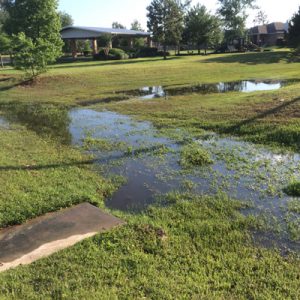
Standing water is not only an eye sore, but also can become a serious health problem:
Problems with lawn drainage prevents family gatherings and outdoor activities until the soil has completely dried out. And like a child finding a puddle, your dog runs through it and tracks mud everywhere.
Walking on a wet lawn can cause soil compaction, which is also bad for your plants.
And, sitting water close to your house’s foundations may seep into walls, causing mold and cracks after drying.
Standing water is not only an eye sore, but also can become a serious health problem:
• bacteria thrive in a moist environments
• it often ends up contaminated by human or animal waste
• it promoted ugly green scum
• if pets or small children drink even a tiny amount of this water, they can become very sick
• many insects, especially mosquitoes, breed in standing water, and mosquitoes carry Zika virus, West Nile virus, and some varieties of encephalitis.
• vermin, such as mice, rats, possums are attracted to watering holes, and they also carry disease and spread their waste
What Causes Standing Water?
Poor grading around home
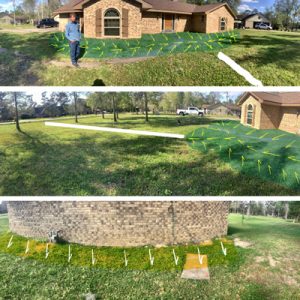
A positive slope prevents water from standing too close to the home.
If you don’t have good grading around your home, standing water is just a matter of time. The terrain around your house should always slope down from the building. Most homes may be initially built with proper grading, but in time the soil settles enough that it begins to dip lower than the surrounding soil. Water finds the path of least resistance, and run downhill into this depression, and absorbs into the dirt around the foundation.
A well drained property slopes gradually away from the house, at a descending elevation of 6 inches over the initial 10 feet (or 5% slope) surrounding the foundation, walkways, and driveway, and another foot of slope over the next 100 feet. This is called a positive slope and is in most instances is enough to prevent water from standing too close to the home.
Grading a property to have a positive slope to push water away from the home is not necessarily a ‘do-it-yourself’ job unless you have the right equipment and experience. Manually, it can be quiet labor intensive. Often you will need to check for utility lines (underground cables) or piping before the and dirt is moved. Some areas require a digging permit before leveling your yard. The basic formula for calculating slope is rise over run. It’s possible to use a stake and string, and a carpenter’s leveler to calculate slope. Or, you can have Daniel Dean survey your property to determine the correct yard slope. Daniel Dean will removed the top 6 inches of topsoil, grade your yard to to the correct slope–taking into consideration of surrounding water shed and topography–and spread grass seed to keep the soil in place.
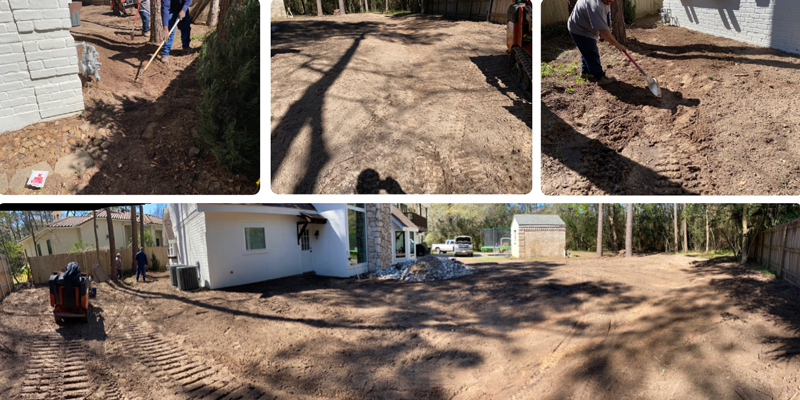
Bad subsoils
The types of subsoils on your lot can greatly affect the water conditions of the property. There are certain soils that are nearly impossible to dry out once they get wet.
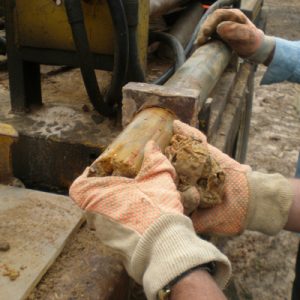
The best way to find out more about the soil in your yard is to have a soil test done.
Your soil type… a simple test
Dig 12 to 20 inches through your top soil to reach your subsoil. Gather a handful of this subsoil and squeeze the soil tightly in your hand and then release your hand and see what happens. If the soil forms a tight ball and keeps its shape, you have a high clay content. If the soil forms a loose ball but crumbles when you touch it, you have loam. And if the soil immediately loses its shape, you have sand.
- Clay packs neatly and resist water and they drain very slowly
- Loam soil holds moisture and promotes plant growth
- Sandy soil can be compacted tightly and it drains well. There is less sandy soil in the Houston area than loamy and clay soils.
If poor subsoils were used to backfill around your home, the best solution is a soil correction. These are not cheap, but are a long term fix that prevents water from slowly damaging your yard.
The best way to find out more about the soil in your yard is to have a soil test done. Daniel Dean can provide a soil test to determine how your yard will drain. He has years of knowledge on drainage systems and can look at your property holistically and create a drainage solution that fixes your drainage problems.
Hardpan
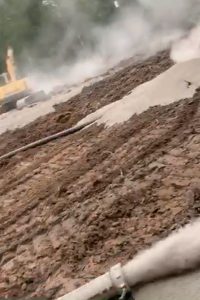
Acid reducing agents, such as gypsum, can help loosen hardpan clay.
Hardpan is a layer of soil just below your topsoil, and is compacted so tightly that water cannot penetrate. A soil tester can determine if hardpan is present. Another indication is where plant’s roots grow horizontally, or where water remains days after a rain.
There are different types of hardpan. Some occur through acidic mineral deposits, such as iron oxides and calcium carbonate. Soil heavy in clay and sodium are easily compacted. Constant use of heavy machinery or traffic also cause hardpan.
To prevent standing water and have a healthy plant life and soil microbiome, hardpan needs to be dealt with. Breaking through hardpan often requires heavy machinery, such as a chisel plow, broad fork or backhoe. After hardpan has been broken up, soil amendment should be used to promote further dissolution and encourage organic soil matter. Organics like manure, compost or peat improve drainage. Acid reducing agents, such as gypsum, can help loosen clay.
Daniel Dean has the right equipment to deal with hardpan soil. And, in his 30+ years of experience in commercial and residential drainage, he has solved many types of hardpan problems.
Low spot in yard
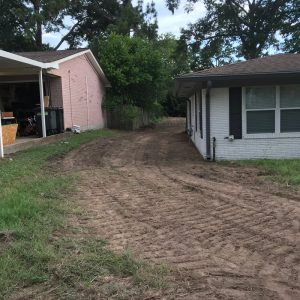
If you live at the bottom of a hill or in areas of low elevation, water can collect and not drain.
If you live at the bottom of a hill or in areas of low elevation, water can collect and not drain. Your property then becomes the catch basin for all the water from higher elevations. If you’re considering increasing the elevation in the low area by adding fill sand, you may be creating a bigger problem by pushing uncontrolled water to another area. Depending on where you live, some property border regulated areas, such as wetlands where soil types and existing vegetation take priority, or habitats for endangered species or green zones that have to remain untouched.
Low spots in yards often require regrading or a drainage plan. Daniel Dean has created solutions for low spots in yards by creating berms and swale to redirect water, drains, dry wells, retaining walls, catchment basins and ponds, underground pipe, etc.
Additionally, Daniel Dean can help with the draining planning that will keep you friends with your neighbors and safer from legalities.
High water table
If your standing water is not coming from surface water, but actually from subsurface water you may have a high water table. If you live near a lake or river, or area where there’s a constant source of water that receives more water than can be drained, this is a sign of a high water table. There is also the possibility that you have a false high water table which can occur from poor soils. A high water table can cause septic systems to fail and ruin crops or grass by encouraging mold.
If you are struggling with standing water due to a high water table, you should hire a structural engineer or an experienced contractor, such as Daniel Dean, to design you with a drainage system that will work best for your property.
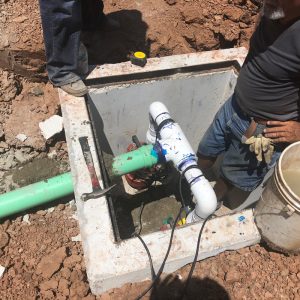
During heavy rains, an underground sump pump discharges large volumes away from your house.
An underground pipe drainage system is often the best solution. Underground pipes can reroute water away from the property into a storm collection system, or to retention pond or detention pond. Depending on the severity of the issue you may need to install a sump pump system, soil correction, or other yard drainage system.
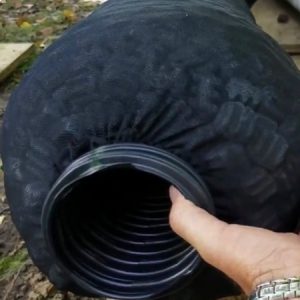
Geotextile filter fabric prevents sediment from clogging underground drainage pipes.
The pipes are laid on the gravel-lined underground channel, protected with filter cloth to keep sediment from clogging the pores; concrete pipe sections are placed with a gap between each that allows water in. The channel is sloped slightly to allow runoff to drain. In perforated pipes, the water releases slowly through the pores, and infiltrates into the ground, with excess water carried away to an acceptable discharge point.
Some homes with a high water table incorporate a built-in drainage system. Within the foundation is a system of perforated pipes parallel to the bottom of the house’s foundation and drain into an under ground pit (the sump). The switch turns on the sump pump when the water level in the sump pit rises and pumps the water out of the pit and into a pipe which ejects the drainage water.
Run-off water: paved surfaces and roof water management
Water that does not get absorbed into the soil will flow downhill as runoff. Paved surfaces—such as driveways, parking lots, roads and sidewalks—and rooftops prevent water from immediately soaking into the ground, where it would have been filtered and stored as groundwater.
Run-off water in residential and industrial can carry harmful chemicals, fertilizers, pesticides, dirt and bacteria, which eventually ends up in our rivers, lakes, and streams as pollution.
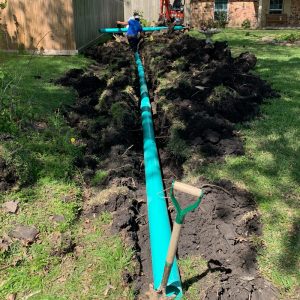
Solid pipes are used for drainage where it’s desirable for water to be quickly conveyed away.
Pipes used for subsurface drainage are initially typically 4 inches in diameter, and solid or perforated plastic, or clay pipe sections. Solid pipes are used for drainage where it’s desirable for water to be quickly conveyed away. A solid pipe may connect to a downspout to drain roof runoff a safe distance from the foundation.
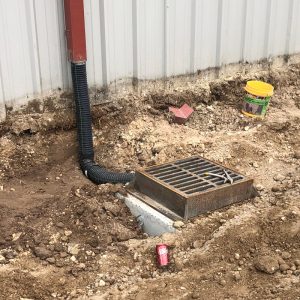
Downspouts and extensions move water away from your building’s foundation.
If a proper roof water management system is not working properly, issues like standing water could occur. Rain water will flow off of your roof, land near your foundation and pool or seep into surrounding soil to saturate the perimeter of your house or business. Standing water near your foundation is never good because it will eventually cause foundations issues. Downspouts and downspout extensions are responsible for moving water away from the foundation of your building.
Properly installed sidewalks and driveways are critical to preventing standing water and other drainage issues. Placement and slope are two of the most effective solutions to prevent driveway and sidewalk problems. Avoid low areas and gently slope the surface towards the area where water will flow for further disbursement.
Daniel Dean creates commercial and residential drainage solutions to redirect runoff water and prevent standing water on your property.
How do I fix my drainage problem?
Drainage Solutions
 Before a sensible, long-lasting solution can be developed, you have to understand what causes your standing water drainage problem. Topography is the key thing to consider, such as:
Before a sensible, long-lasting solution can be developed, you have to understand what causes your standing water drainage problem. Topography is the key thing to consider, such as:
All these issues can be overcome by working with nature to redirect water flow to areas that are prepared to received it.
Grading
“It’s crazy to think that we often have to fix final grading around the house 10 or 15 or 20 years later because it wasn’t properly done in the beginning.”
Daniel Dean
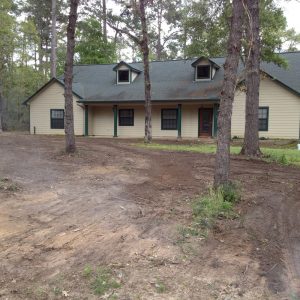 It’s most important to have water drain away from your property, and it’s strongly recommended hiring a professional, such as Daniel Dean, to help you grade your property correctly the first time. The process involved to grade your yard may seem simple, but there are a lot of things to consider:
It’s most important to have water drain away from your property, and it’s strongly recommended hiring a professional, such as Daniel Dean, to help you grade your property correctly the first time. The process involved to grade your yard may seem simple, but there are a lot of things to consider:
- Know what’s buried beneath your lawn. Make sure it’s free of pipes, cables or septic systems that run to your house or business. Suitable utility locating tools are recommended to detect buried services. For larger jobs, before excavation, it’s always safest to get the help of your local utility company.
- Find your slope. Professionals use a slope measuring device, such as laser range finder, precision altimeter or an inclinometer. Do-it-yourselfers use wooden stakes, string, line leveler and a tape measure.
- Mark your high and low points of your yard and bring in your topsoil. Smooth the dirt with a rake gradually from high points to lower points, always sloping away from the house.
- Compact dirt. Again, a professional has the equipment to compact dirt in layers, and avoid soft spots where erosion will start.
- Plant new grass squares or spread seeds. Rye grass properly watered daily typically sprouts within a week. Covering seeds with hay or yard clippings helps keep soil most.
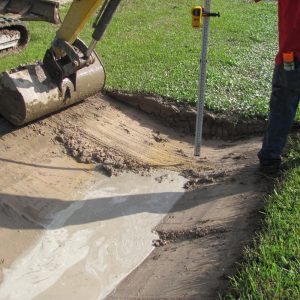 Ditches also need regrading from time to time because of increased water flow, washed away vegetation, blocked channels or increased sediment load. Many rural roadside ditches are merely excavated rather than designed. As conditions of the ditch change, maintenance is required.
Ditches also need regrading from time to time because of increased water flow, washed away vegetation, blocked channels or increased sediment load. Many rural roadside ditches are merely excavated rather than designed. As conditions of the ditch change, maintenance is required.
Culverts
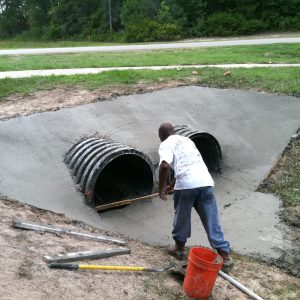
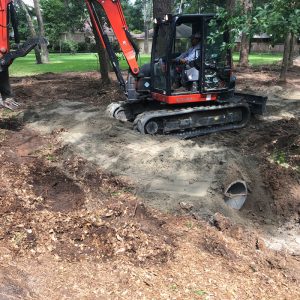
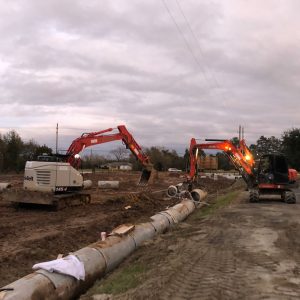 A properly designed and constructed culvert will not only stand the test of weather and time but also will be in place when needed the most. While there are many types of culverts, the most common is the pipe culvert due to their competitive price and easy installation. Generally, their shapes (circular, elliptical and pipe arch) depend on site conditions and constraints. Pipe culverts can be made from metal, plastic or concrete, and in sizes typically from 6 to 60 inches. Pipe culverts are used along the roadside ditch, under a driveway or as a creek crossing.
A properly designed and constructed culvert will not only stand the test of weather and time but also will be in place when needed the most. While there are many types of culverts, the most common is the pipe culvert due to their competitive price and easy installation. Generally, their shapes (circular, elliptical and pipe arch) depend on site conditions and constraints. Pipe culverts can be made from metal, plastic or concrete, and in sizes typically from 6 to 60 inches. Pipe culverts are used along the roadside ditch, under a driveway or as a creek crossing.
While there are specific benefits to choosing culvert material and size, here are Daniel Deans best practices for pipe culvert construction:
- get professional advice. Do it right, do it once.
- an 18-in corrugated metal pipe (CMP) or high-density polyethylene (HDPE) culvert offer the strongest, most economical and easiest to clean pipe
- Use at least 18 inches of clean, compacted cover over the pipe and as backfill. Poor compaction and debris-laced fill are the most commonly diagnosed failures in culvert crossings.
- In creek crossings, multiply the average depth by the average width to obtain the cross-sectional area, and divide by four to determine the rough diameter of pipe needed to pass an average storm.
- Place multiple culvers a foot or two apart so soil can be worked into a tight bond.
- Construct road section low to allow storm flow to pass over the roadway.
- Use maximum slide slopes of 2:1 to reduce erosion and promote vegetation, and road surface width at least 12 feet to calculate pipe length. .
- Use riprap or concrete rubble on the ends of culverts for scour protection.
Ask Daniel Dean what type of culvert works best in your circumstance.
Swales
 A swale can take many forms. It can be a gentle, almost invisible sloped, grass-bottomed ditch in the yard that helps hold or channel rainwater as it flows across your lawn. The goal is to slow down and hold the runoff so the water can soak through the soil and into groundwater aquifers. Or, the swale can be engineered to direct the runoff water away from the home foundation to a landscape feature or exit point.
A swale can take many forms. It can be a gentle, almost invisible sloped, grass-bottomed ditch in the yard that helps hold or channel rainwater as it flows across your lawn. The goal is to slow down and hold the runoff so the water can soak through the soil and into groundwater aquifers. Or, the swale can be engineered to direct the runoff water away from the home foundation to a landscape feature or exit point.
Because swales must slope downhill, they should be deeper as they get longer, sloping at least 1 inch for every 10 feet of length.
In areas of frequent heavy rainfalls, a swale may need more sophisticated engineering. For example, the bottom of the swale may be engineered with a layer of gravel and porous drain tile tubing buried beneath the surface. This allows water to be drained off more quickly. Small swales can direct gutter water to a dry well, while more substantial ones could run along the base of a hill to divert water around a low-lying house.
You can build a small swale yourself, but should hire a professional, such as Daniel Dean, who has the proper earth-moving equipment for a long, wide one. Daniel Dean understand how a swale should be constructed:
 the sides of the swale should flare so they extend out three to four times more than they are tall
the sides of the swale should flare so they extend out three to four times more than they are tall- the first 8 inches of soil should drain well. If your soil drains too quickly, it can just be loosened. If water sinks in too fast, blend it with 40 percent compost.
- where drainage is very slow, replace soil with 60 percent screened sand and 40 percent compost.
- if the swale itself can’t be made big enough to evacuate all the water, consider excavating another 6 to 8 inches. Also, lining the trench with filter fabric and perforated pipe, then covering it with round ¾-inch gravel will help. Top the gravel with at least 8 inches of a compost-rich soil mix.

